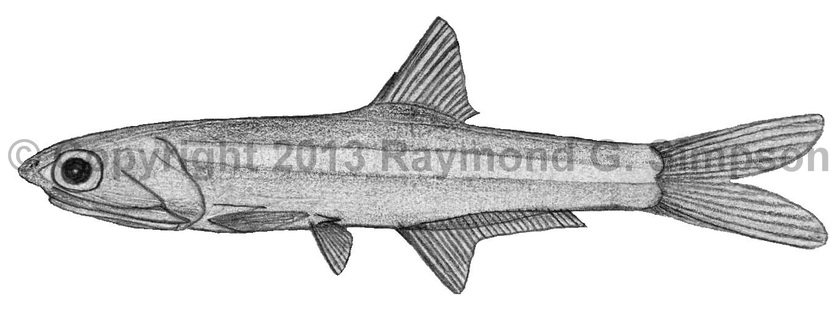
Common Name
Key Anchovy
Year Described
Fowler, 1906
Identification
Dorsal Fin: 13-15
Anal Fin: 25-29
Pectoral Fin: 12-13
Gill Rakers: 13-15 upper, 15-17 lower
Vertebrae: 43
Lateral Line Scales: 39-42
Body elongate and laterally compressed. Body depth 19-23% TL. Snout conical and a little less than eye diameter. Mouth very large and inferior. Maxilla tip extends over preoperculum. Teeth small. Suborbital bone about as large or a bit larger than eye diameter. Pseudobranch shorter than eye diameter (does not reach onto operculum). Dorsal fin origin a little past midpoint of body with a concave rear margin. Pectoral fin long, low and barely reaches pelvic fin base. Pelvic fin a bit closer to pectoral base than it is to anal fin origin. Pelvic fin with seven rays. Anal fin origin under middle of dorsal fin and has a long base. Caudal fin forked. Anus closer to anal fin than pelvic fin base. Scales cycloid and deciduous. Lateral line absent.
Color
Body translucent with a wide (about eye diameter) silvery stripe that does not narrow significantly. Fins clear.
Size
Maximum size to 85mm TL.
Habitat
A coastal species found in clear marine waters. Schooling.
Range
Southern Florida to the Bahamas, the Antilles, the eastern Yucatan, and continental from Belize to Venezuela.
References
Hildebrand, S.F. 1964. Engraulidae and Clupeidae (pp. 152-454). In: Fishes of the Western North Atlantic. Mem. Sears Fnd. Mar. Res. 1 (Vol. 3): 1-630.
McEachran, J.D. & J.D. Fechhelm. 1998. Fishes of the Gulf of Mexico. Volume 1: Myxiniformes to Gasterosteiformes. University of Texas Press, Austin. i-viii + 1-1112.